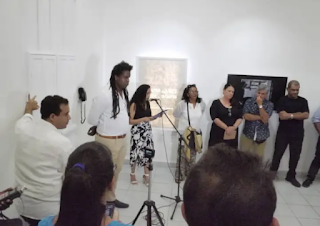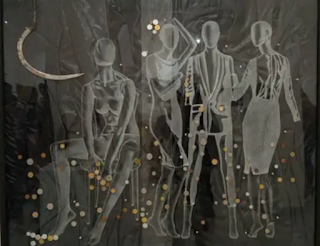Arte Contemporáneo en Santiago de Cuba
¿Hacia dónde se dirige el Arte Contemporáneo en Santiago de Cuba?
En la tarde noche del viernes 23 de septiembre del 2022, se celebró el tan esperado: Primer Salón de Arte Contemporáneo de Santiago de Cuba, en conmemoración al aniversario de la Fundación Caguayo y el natalicio del escultor René Valdés Cedeño. Un evento que tuvo una semana cargada de actividades dedicada a incentivar y reavivar todo lo relacionado con el arte que se gesta en estos tiempos en la cuidad. Así, se realizaron conferencias y conversatorios entorno al mercado y la crítica de arte en dicha provincia. A la vez, que se hizo eco la magistral conferencia realizada por Pilar Vázquez, representante en Cuba de la Plataforma virtual Arte Morfosis, en cuanto a arte digital respecta y las oportunidades que brinda dicha plataforma a los artistas cubanos en pleno siglo XXI.
Como muchos saben, las artes visuales en Santiago de Cuba en los últimos años se ha hecho visible gracias a unos pocos –por cierto jóvenes- que a pesar de las circunstancias y su amor por el arte no han dejado de crear; de tal manera que hemos podido visualizar en varias ocasiones obras de artistas como Alejandro Lescay, Miguel Yaimel Cosme Pérez, Frank Lahera y Yuri Seoane. Igualmente, desde el Centro de Artes Visuales y Diseño, se han llevado a cabo magníficas propuestas de artistas como Danis Montero y Carlos René Aguilera.
Ahora bien, el Salón sería el gran evento que, como en efecto, logró reunir en una misma sala tanto a artistas jóvenes como consagrados, algunos, en mi opinión, no merecedores de estar allí. De acuerdo con las declaraciones del jurado de admisión, conformado por Alejandro Lescay, Carlos René Aguilera, Grettel Arrate, Yuliet Hechavarria y Maciel Reyes; se había realizado una rigurosa selección de las obras enviadas, con el fin de aglutinar dentro de lo posible, un conjunto homogéneo de lo más actual o “contemporáneo” del arte santiaguero.
De tal manera, de 34 artistas santiagueros, quedaron seleccionadas 16 obras de 21 de ellos: Arlena Sera, Danis Montero, Edgar Brielo, Isabel Palma, Jorge Hernández, Julio Pérez, Julio Carmenate, Marlon Aguilera, Miguel Y. Cosme, Renato Arza, René Noa, Román Pérez, Susana Soria, Vivian Lozano, Yuliet Labrada, Yuri Seoane.
Las piezas, fueron montadas en la Galería de Arte “René Valdés Cedeño”, una institución privilegiada, que desde su posición, intenta situar al arte santiaguero dentro de las artes visuales contemporáneas de la Isla.
Se dieron cita en este Salón, producciones artísticas que van desde la pintura, la escultura, la fotografía, la instalación y el videoart. Con lo que se pudo comprobar un aumento de la fotografía por parte del interés de los artistas, mientras que por otro lado, se sintió la casi nula existencia del grabado como tendencia representativa del arte de la provincia. Muchas de las piezas que se presentaron ante un público que se disfrutaba, discutía y reflexionaba; carecían de rigor estético y espíritu creativo, donde predominaba el facilismo y el empleo de fórmulas pasadas; junto con otras que sí mostraban en todo su esplendor una capacidad expresiva y creativa, llenas de frescura y espontaneidad, dignas de aplausos y honores.
Así, quedó demostrado la preferencia por el arte de las nuevas tecnologías, mientras que las llamadas “bellas artes”, que son en definitiva las que definen a un verdadero artista, quedaron en segundo plano. A lo que yo, como espectadora me pregunto – si un Salón constituye el espacio idóneo para mezclar orgánicamente todas las manifestaciones visuales, por qué comparar o darles más valor a tales manifestaciones, dígase la fotografía y el videoart, cuando todo arte debería ser “lo más moderno, lo contemporáneo”. Una verdadera obra de arte, lleva dedicación, tiempo, habilidades manuales, técnicas y expresivas; con un nivel de complejidad y acabado; más que simplemente tomar una buena foto o hacer un video, al menos que estos últimos revolucionen lo artístico y lo conceptual. De tal manera que, la pintura o la escultura se convierten en obras obsoletas, y lo tecnológico deviene a ser “lo moderno”. De ser así, entonces todos, sin ser precisamente artistas, podríamos hacer fotografías, videoarte e instalaciones, guiándonos por la lectura de temas filosóficos y creando un concepto en el que las habilidades técnicas y expresivas sean nulas. Por lo tanto, han hecho que el gusto por el buen arte y la expectativa de un público, “inculto por excelencia”, se vuelvan cada vez más banales y efímeras. Claro está, y estoy totalmente de acuerdo, con que el arte debe evolucionar, pero no hacia una involución q va de manera ascendente gracias al arte conceptual, del cual muchos que se consideran artistas, justifican sus faltas de habilidades para según ellos, crear.
Otro aspecto que tuvo el Salón fue que, a pesar de que logró reunir a artistas jóvenes académicos y autodidactas, muchos de ellos no poseían una trayectoria digna de admirar.
No es entendible que siendo este, un evento sumamente importante para la cuidad, y en consecuencia para el país, artistas sin trayectoria tengan una participación.
El jurado de Premiación estuvo integrado por los ya mencionados anteriormente, además de contar con Pilar Vázquez y la destacada figura de la plástica cubana Luis E. Camejo. Se dieron tres Premios Colaterales. El primero, dado por el Consejo Provincial de las Artes Plásticas a el escultor René Noa, por su obra “La persistencia de la fe”, una escultura moldeada desde la técnica de la cera pérdida, que desde la repetida iconografía de la Virgen de La Caridad, pretende trasmitir un discurso visual y espiritual que todo cubano busca a través de la Patrona de Cuba.
El segundo Premio lo obtuvo la obra “Sinfonía de presión”, del artista Yuri Seoane, dado porla Asociación Hermanos Saíz. Una obra que a través del videoart, toma elementos circunstanciales del accionismo viénes, tal y como lo muestran los videos que han quedado de dicho movimiento artístico llamado “anti-arte”.
Yuliet Labrada, alcanzó el Premio de ArteMorfosis, por su obra “Ironía del papel amante”.
Una instalación que basada en el arte conceptual, pondera la idea o concepto por encima de la habilidad técnica y creativa de la artista.
Las menciones las obtuvieron Arlena Sera con dos fotografías de la Serie “”Huellas”, Julio Carmenate con su instalación “La armonía de un discurso” y la ya mencionada Yuliet Labrada. Mientras que el gran Premio fue para Yuri Seoane.
Como ya he mencionado antes, el Salón es evidentemente positivo para el desarrollo y la posterior visibilidad del arte santiaguero. Sin embargo, resulta lamentable el hecho de que si las obras expuestas eran las mejores, porqué no darles un reconocimiento a los otros participantes?; siendo este acontecimiento el primero que se realiza en la cuidad. O es que acaso los otros artistas no lo merecían? Y es que la exposición, a pesar de presentarnos una multiplicidad de imágenes, como en efecto, se vuelve repetida y cansona; como si ya esa presentación se hubiera observado con anterioridad. Mención aparte merecen entonces, las obras de Danis Montero, Jorge Luis Hernández Pouyu, Edgar Brielo, Susana Soria y Miguel Y. Cosme, por la acentuada autenticidad y expresividad creativa que demostraron, cada uno desde lo que le gusta hacer.
Finalmente considero que, en este Salón, en su primera edición no se logró lo que realmente se esperaba. No obstante, cumplió con sus objetivos principales: servir de estímulo y comprometer aún más, a través de un trabajo serio y concienzudo que cada obra exige, a los creadores santiagueros. Del mismo modo, tal suceso constituyó la cantera para que estos que ya están y los futuros, muestren el valor que posee el arte contemporáneo santiaguero ante el arte contemporáneo de Cuba en general.
Anisleydi Claramunt Contreras
Where is Contemporary Art headed in Santiago de Cuba?
On the evening of Friday, September 23, 2022, the long-awaited First Hall of Contemporary Art of Santiago de Cuba was held, in commemoration of the anniversary of the Caguayo Foundation and the birth of the sculptor René Valdés Cedeño. An event that had a week full of activities dedicated to encouraging and reviving everything related to the art that is developing in these times in the city. Thus, conferences and talks were held around the market and art criticism in that province. At the same time, the masterful conference given by Pilar Vázquez, representative in Cuba of the Virtual Platform Arte Morfosis, was echoed, regarding digital art and the opportunities that this platform offers to Cuban artists in the XXI century.
Anisleydi Claramunt Contreras
Curadora de arte











Comentarios
Publicar un comentario